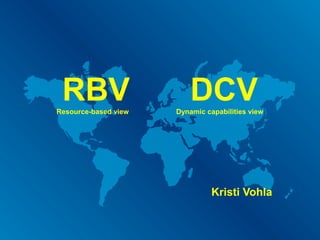
RBV, DCV
- 1. RBV DCVResource-based view Dynamic capabilities view Kristi Vohla
- 2. Ressursipõhine teooria (RBV – Resource-based view) • “inside-out” – RBV keskendub ettevõtte sisestele oskustele ja võimetele • Ettevõtte sisesed ressursid, nende läbi püsiva konkurentsieelise tagamine • RBV kontsept: • Selgitada välja ettevõtte võtmeressursid • Hinnata ressursse vastavalt (VRIN) kriteeriumitele • Hoida ja kaitsta kriteeriumitele vastavaid ressursse, sest need tagavad organisatsiooni tulemuslikkuse
- 3. (VRIN) Barney, J. (1991). Firm Resources and Sustained Competitive Advantage. Journal of Management, 17, 99-120 • Väärtuslik (Valuable) – ressursil peab olema strateegiline väärtus ettevõtte jaoks (p 99) • Haruldane (Rare) – ressurss peab olema unikaalne või haruldane olemasolevate ja tulevaste konkurentide jaoks (p 106) • Imiteerimatu (In-imitable) – ressurssi ei ole võimalik täpselt kopeerida (p 107-111) • Asendamatu (Non-substituable) – ressurssi ei saa konkurendid asendada alternatiivsetega saavutamaks sama tulemust (p 111)
- 4. Võtmesõnad: • Ressursid (Resources) organisatsiooni “ehitusmaterjal”, millega luuakse eeldusi eesmärkide saavutamiseks ning määratakse strateegia elujõud • Konkurentsieelis (Competative advantage) oskuste, tehnoloogiate, teadmiste ja ressursside integreeritud kombinatsioon, mis läbi organisatsioonilise õppimise on arendatud täiuslikkuseni. Kompetents on võime kasutada ettevõtte spetsiifilisi ressursse, et saavutada eemärk • Võimekus (Capability) viitab kompetentside strateegilisele kohandamisele ja nende kasutamisele ja kasutuselevõtule, et saavutada organisatoorsed eesmärgid.
- 5. Barney, J. (1991). Firm Resources and Sustained Competitive Advantage. Journal of Management, 17, 99-120 • “...firm resources include all assets, capabilities, organizational processes, firm attributes, information, knowledge, etc; controlled by a firm that enable the firm to conceive of and implement strategies that improve its efficiency and effectiveness”(Barney p 101) • Ressursid (Resources) (p 101) • Physical capital resources • Human capital resources • Organizational capital recourses • Konkurentsieelis (Competitive advantage) • Firm is implementing a value creating strategy not simultaneously being implemented by any current or potential competitors (p 102) • Püsiv konkurentsieelis (Sustained competitive advantage) • Firm is implementing a value creating strategy not simultaneously being implemented by any current or potential competitors AND when these other firms are unable to duplicate the benefits of this strategy (p 103) “Firm resources can only be a source of competetive advantage or sustained competative advantage when they are valuable.” (p 106)
- 6. Amit, R.; Schoemaker, P.J.H. (1993), Strategic assets and organizational rent. Strategic Management Journal, 14, (1), p. 33–46 • Varasemalt oli käsitluses “ressursid”, mida nüüd jagatakse “ressursid” ja “võimekused” • Ressursid (resources) on olemasolevate tegurite varud, võimekused (capabilities) on organisatsiooni suutlikkus kasutada neid varusid. • Võimed ja varad on firmades jaotunud assümeetriliselt. • Amit ja Schoemaker pakuvad praktilisemaid lähenemisviise. Lähtub sellest, et ressursid on sisendid ja tegurid, mis on organisatsioonile kättesaadavad ning aitavad edukas olla.
- 7. Dünaamiliste võimaluste vaade (DCV – dynamic capabilities view) • DCV põhineb RBT’l • Täpsustab, milliseid ressursse on organisatsioonil vaja, et tagada konkurentsieelis • DC on organisatsiooni suutlikkus integreerida, ehitada ja ümberkujundada sise- ja välispoliitikat kohandumaks ümbritseva olukorra ja keskkonnaga.
- 8. Dünaamilised võimekused Võtmesõnad: • Learning Organisatsioonid peavad olema õppimisvõimelised, et võimaldada ettevõttel uuendada ja kohandada ettevõtte jaoks olulisi sisemisi ning väliseid kompetentse • New assets Tulemuslik ja tõhus sisemine kooskõlastus ning strateegiliste väärtuste integratsioon määravad majandustulemusi. • Transformation of existing assets Kiiresti muutuvad turud nõuavad kiiret kohanemisvõimet ettevõtte väärtustestruktuuris. Võime muutuda vastavalt olukorrale sõltub võimest skaneerida olukorda, hinnata turgusid ning teostada rekonfigureerimist.
- 9. D.J.Deece, G.Pisano, A.Shuen. (1997)Dynamic capabilities and strategic management. Strategic Management Journal, vol 18:7, 509- 533 • Dynamic – capability to renew competences so as to achieve congruence with the changing business environment • Capabilities - key role of strategic management in appropriately adapting, integrating, and reconfiguring internal and external organizational skills, resources, and functional competences to match the requirements of a changing environment • “..the firm’s ability to integrate, build, and reconfigure internal and external competences to address rapidly changing environments.” • “A real key to a company’s success or even to its future development lies in its ability to find or create ‘a compentence that is truly distinctive’” • “The competitive advantage of firms lies with its managerial and organizational processes, shaped by its (specific) asset position, and the paths available to it.”
- 10. RBV vs DCV • Kui RBV rõhutab sobivate ressursside valikut, siis DCV rõhutab pigem ressursside arendamist ja uuendamist • “Regarding the difference between capabilities and resource, the former is specific to and deeply hidden in a firm and its processes. When a firm is transferred or the organization disappears, its capabilities just disappear.” (Teece et al 1997)
- 11. Kriitika • The RBV seems to assume what it seeks to explain. This dilutes its explanatory power. For example, one might argue that the RBV defines, rather than hypothesizes, that sustained performance differences are the result of variation in resources and capabilities across firms. The difference is subtle, but it frustrates understanding the RBV’s possible contributions. • RBV on tautoloogiline • Samasugused ressursid võivad olla mitmes firmas (ei ole konkurentsieelis) • Kaubaturgude roll on ebaoluline • Ei arvesta ressursse ümbritsevaid faktoreid, selle asemel eeldatakse, et need lihtsalt eksisteerivad
- 12. Kriitika (Barney, 1991) • On keeruline (kui mitte võimatu) leida organisatsioon, mis vastaks kõigile VRIN kriteeriumitele • Eeldatakse, et ettevõte võib olla tulus tiheda konkurentsiga turul seni, kuni tema kasutada on VRIN ressursid • Ettevõte ei saa juhtida ressurssi, mille olemasolust ta teadlik ei ole, isegi kui muutuv keskkond seda nõuaks • Eeldatakse tõhusaid turgusid. • Teooria “haruldus” on aegunud • Pigem teoreetiline kui praktiline
- 13. Case
